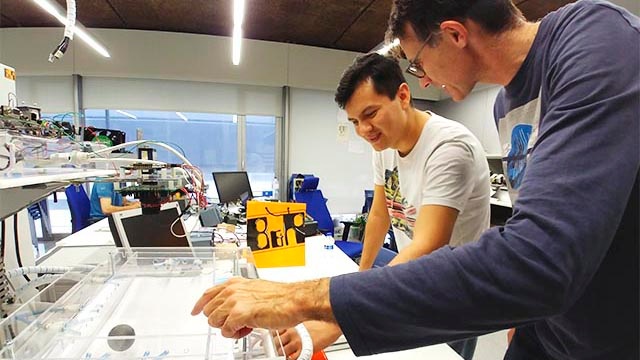The collaboration of the company B&R, leader in machine automation, with the ETSE DIMSAI master, focused on the training of industrial automation technologies, has been key to the development of a system of location and tracking based on event viewing camera has just been recognized as the best of Europe that apply Ethernet Powerlink technology. Precisely, the creator of this open communication language between devices is this company that is located in the University of Valencia Science Park.
The recognition was granted last October 20 in Austria during the final of the European Industrial Ethernet Award, to which came five of the 26 university canidate teams. The sponsor of the competition is Ethernet Powelink Standarization Gropup (EPSG), a conglomerate of companies that make use of this technology, and the objective of the contest is to identify the best science-based engineering project developed by an university team making use of this open technology. "One of the aspects that is most valued by the jury is precisely the combination of research and technological development," explains Marcos García, responsible for the Mediterranean area of B&R. "And in this case, the project counts with both a scientific paper and the development of a functional and operational prototype," explains Juan Barrios, PhD student and author of both corpus for his doctoral thesis.
"Following one of the lectures we gave in the master's degree, in which B&R presented this open and recognized technology with an IEEE standard, the director of the DIMSAI master,Alfredo Rosado, and his doctoral student Juan Barrios took the witness to give a practical and industrial development to the project of a vision camera that already had a consolidated theoretical research", explains Marcos García.
"What we did from the ETSE", continues Alfredo Rosado, "is to develop all the electronics of a camera prototype designed by the research group led by computer science professor Fernando Pardo. This type of cameras are very new in the world, because they are working on only three or four computers, and what they allow is to register certain movements with very little computational load. This is very interesting when it comes to processing images in industrial tasks of very high speed and offers very good results in terms of motion detection. "
In particular, what Alfredo Rosado and Juan Barrios have developed is "to connect the camera to the industrial environment and from that, to develop a two-axis robot that is positioned in function of the detections of the movement that the camera is detecting. It's all a bundle of algorithms developed by us plus the hardware facilitated by B & R and that allows to compact everything to have unique functionality ", they underline.
"What we did from ETSE," continues Rosado, "is to develop all the electronics of a camera prototype designed by the research group led by computer science professor Fernando Pardo. This type of cameras are very new in the world and what they allow is to register certain movements with very little computational load. This is very interesting when processing images in very fast industrial tasks and offers extraordinary good results in terms of motion detection".
In particular, what Alfredo Rosado have done with Juan Barrios, whose thesis explains this project, is "to connect the camera to the industrial environment and from that, to develop a two-axis robot that is positioned according to the movements that the camera detects. It is a mix of algorithms developed by us plus the hardware facilitated by B&R and that allows to compact everything and have an unique functionality. This is precisely what the edition of the European awards has valued, it is, the development of both, the research part and the industrial part", Rosado underlines.
Future applications
To give a practical example, this industrial prototype could be implanted in a conveyor belt of objects. Through the camera the movement of the piece that runs through it can be detected and then directed to a clamp to grasp it. "The advantage is undoubtedly in the low computational load required by the camera," they stress.
The European recognition involves the delivery of 10,000 euros "that we will invest in building a larger robot, a robot that is comparable in the industrial environment. If there were companies interested in acquiring it, we could develop agreements with them. we usually do this to support companies in the implementation of our automation", says Rosado.


